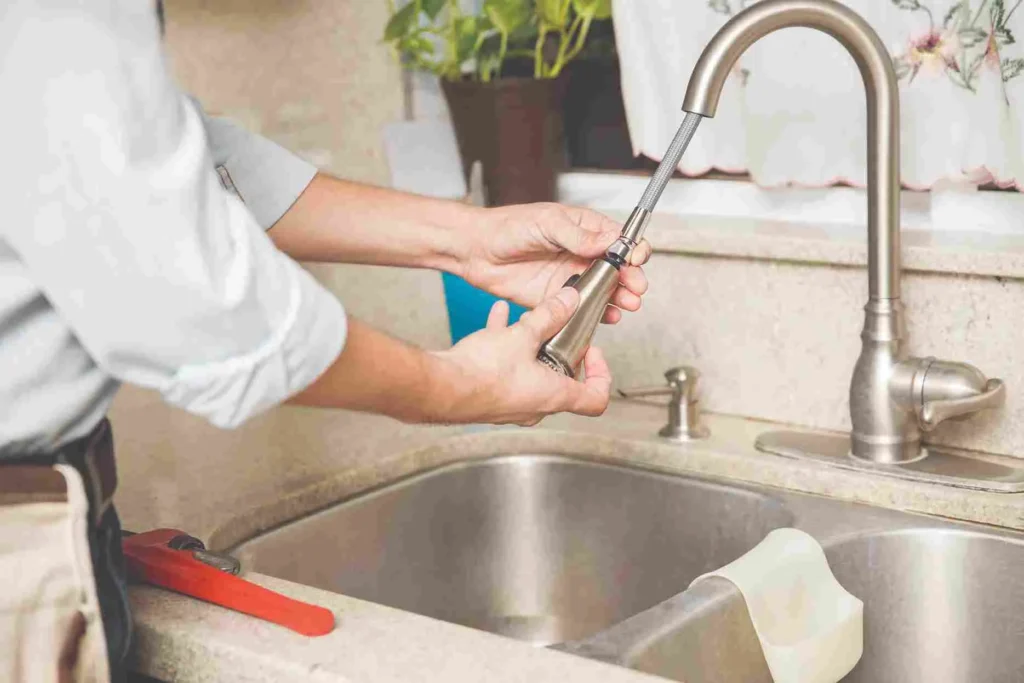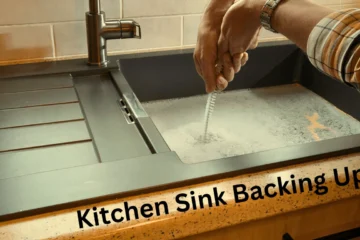Sudden low water pressure in kitchen sink can be irritating, especially when you are in the middle of cooking or cleaning. This common issue may be due to various factors, ranging from simple blockage to more complex plumbing problems. Understanding these causes and how to address them can help you rapidly restore your water pressure. In this article, we’ll explore the potential causes of low water pressure in your kitchen sink, provide practical solutions, and offer tips for preventing the problem from happening again.
Table of Contents
Understanding Water Pressure and Why It Is Important
water pressure forces water out of your faucets through your pipes. Most houses may have a pressure range of 38 to 58 pounds per square inch(psi), the standard pressure. Daily chores like washing dishes, washing hands, and filling pots become more time-consuming and difficult when the water pressure of your kitchen sink is too low.
Sudden low water pressure in your kitchen sink may indicate something is wrong with your plumbing system and must be fixed. Ignoring this issue may cause more severe problems, such as broken pipes, higher water bills, and no water flow in your house.
Causes of Sudden Low Water Pressure in Kitchen Sink
You might experience sudden low water pressure in your kitchen sink for several reasons. Some of the most common causes are
- Clogged Faucet Aerator
There is a minute mesh screen on your faucet’s end called a faucet aerator. Air is added to the water stream to provide a smoother flow and help to save water. Ultimately, debris, mineral deposits, and sediment can build up in the aerator and block it. Reduced pressure from clogged faucet aerators limits the flow of water.
- Sediment buildup in Pipes
If you live in an area with hard water, which contains high levels of minerals like calcium and magnesium, sediment can build up in your pipes over time. Sediment narrows the diameter of the pipes, restricting water flow and causing a noticeable drop in water pressure. Sediment buildup is more common in older home’s plumbing systems.
- Partially Closed Water Supply Valve
The water supply valve manages the flow of water to your kitchen sink. A partially closed or broken valve, which limits the water flow, may cause low pressure. The valve may also become rusty over time or accidentally turn off during maintenance, resulting in sudden low water pressure in kitchen sink.
- Leaks in the Plumbing System
A leak in your plumbing system may considerably decrease your water pressure. The pressure will drop if a pipe leaks water before it reaches your kitchen sink. Your plumbing system may have leaks under the sink, walls, or main water line.
- Faulty Pressure Regulator
A pressure regulator manages your home water pressure. If it’s broken or not adjusted properly, it can lower water pressure in your home, especially at your kitchen sink. Restoring appropriate water pressure will require a pressure regulator that maintains the water pressure of your kitchen sink.
- Clogged or Corroded Pipes
Not only can sediment build up in pipes, but they can also rust or get clogged with debris over time, especially in older homes. Sudden low water pressure in kitchen sink may caused by obstructions in corroded pipes that limit the flow of water. Because galvanized steel pipes are likely to rust and corrode, this problem will likely arise in homes with such pipes.

Repairing Low Water Pressure in Your Kitchen Sink
You can repair and determine the main issue if your kitchen sink isn’t generating enough pressure. These are the following steps to maintain water pressure:
- Check Other Faucets in Your Home
First, check the other faucets in your house; if they are working correctly and have enough water pressure, and the kitchen sink is experiencing low pressure, the fault is in your kitchen sink. If more than one faucet is impacted, your pressure regulator or central water supply may be the problem.
- Inspect the Faucet Aerator
Remove the aerator from the faucet and look for any distinct clogging. If buildup is obstructed by debris or mineral deposits, soak the aerator in vinegar for a few hours to dissolve it. Wash the aerator well and replace it with the faucet when it is soaked.
- Check the Water Supply Valve
Ensure the water supply valve underneath the sink is fully open. If it is half closed, turn it counterclockwise to fully open it. If it is rusted or hard to turn, the valve might need to be changed.
- Test the Water Pressure
If the low pressure isn’t just at the kitchen sink, you should check the water pressure in your house. You can do this by connecting a pressure gauge to the main water line or an outside faucet. Should the pressure drop below 40 psi, you might need to change the pressure regulator or seek help from your local water utility.
- Look for Leaks
Looking for leaks means observing the plumbing beneath your sink, looking for things like wetness, water stains, or standing water. It is important to notice the leak in your kitchen sink and repair the leaked part.
Read more: Why kitchen sink leaking from top?
DIY Solutions for Repairing Water Pressure
After determining the reason behind your kitchen sink’s low water pressure, you can attempt the following do-it-yourself fixes to raise the pressure:
- Clean or Replace the Faucet Aerator
As previously described, a blocked aerator is a frequent cause of low water pressure. To ensure ideal water flow, clean your aerator regularly or buy a new one. If you live in a hard water location, you may have to install a water softener.
- Flush the Pipes
If you think your pipe accommodates sediment, consider cleansing the system to eliminate the waste. To accomplish this, remove the faucet head, cut off the water supply, and allow the water to run at maximum pressure for a few minutes. This pressure can assist in moving and clearing any debris or silt that might clog the water flow.
- Adjust the Pressure Regulator
If the water pressure in your kitchen sink is too low, the pressure regulator in your home should be adjusted. You can change the pressure setting on the regulator with a wrench. If you are unsure how to change the pressure settings, seek assistance from a qualified plumber or follow the manufacturer’s instructions.
- Replace Old or Corroded Pipes
Older homes with galvanized steel pipes may have obstructions caused by corrosion, which lowers water pressure. If you’ve tried troubleshooting your pipes and they still don’t work, it could be time to replace them with more contemporary materials like copper or PEX. T
When to Call a Professional
While do-it-yourself projects efficiently fix many water pressure problems, there are instances when hiring a licensed plumber is the best course of action. Here are a few signs that you might want expert assistance:
1. Continuously Low Pressure:
If all repairing methods fail to resolve the sudden low water pressure in kitchen sink, your plumbing system may have a more complicated problem that needs to be professionally repaired.
2. Extensive Pressure Problems:
If low pressure affects several faucets in your house, your main water supply or pressure regulator may be the source. An expert plumber can evaluate the circumstances and choose the best course of action.
3. noticeable signs of Leaks or Corrosion:
It’s critical to have a professional plumber fix any leaks or apparent corrosion in your pipes before the problem becomes worse. Leaks and corrosion can result in water damage, mold development, and even structural damage to your property.
4. Complicated Fixes :
Certain plumbing repairs require specific tools and knowledge, such as repairing pipes or installing a new pressure regulator. To ensure quality work, it’s preferable to employ a professional to complete these activities if you don’t feel confident doing them yourself.
Preventing Future Water Pressure Issues
Regular maintenance and observation are the first steps in preventing low water pressure in your kitchen sink. The following advice will help you maintain the health of your plumbing system and prevent further problems:
Consistently Clean Faucet Aerators:
Maintaining optimal water flow and preventing blockages may be achieved by cleaning your faucet aerators every few months. Consider installing a water softener to lessen mineral deposits in a hard water location.
Check the Water Pressure
Use a pressure gauge to check the water pressure in your house regularly. If you observe variations or a progressive drop in pressure, it might be an early indicator of a growing problem requiring medical treatment.
Verify Plumbing for Leaks
Regularly check your home’s plumbing for leaks in other locations and under the sink. Finding and fixing leaks early on can help maintain steady water pressure and prevent worse issues later.
Arrange for expert inspections.
If you live in an older house, it is advisable to arrange for a professional plumbing examination regularly. Before minor concerns develop into larger ones, a plumber may see any difficulties and suggest any required modifications or fixes.
Conclusion
Sudden low water pressure in kitchen sink is a problem that may be resolved with the appropriate information and strategy. By knowing the typical tips and causes of low water pressure and using the repair techniques mentioned in this article, you can fix low water pressure and keep your plumbing system in excellent operating condition. Low water pressure may be fixed quickly to save more damage and guarantee your kitchen sink keeps working correctly for years, whether you decide to do it yourself or hire a professional.
FAQ’S
Why does my sink suddenly have no pressure?
A sudden low water pressure in kitchen sink is due to a clogged aerator, blockage of pipes, or partially closed water supply valves.
How do I fix the low water pressure in my kitchen sink?
You can fix the low water pressure by cleaning the aerator, which may be blocked with debris, and checking the supply valves to confirm they are fully open





